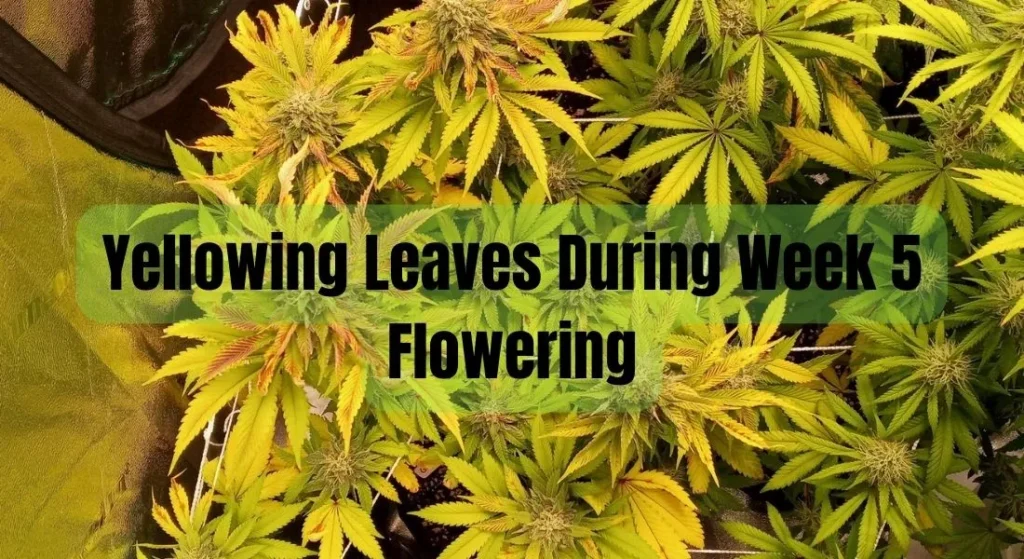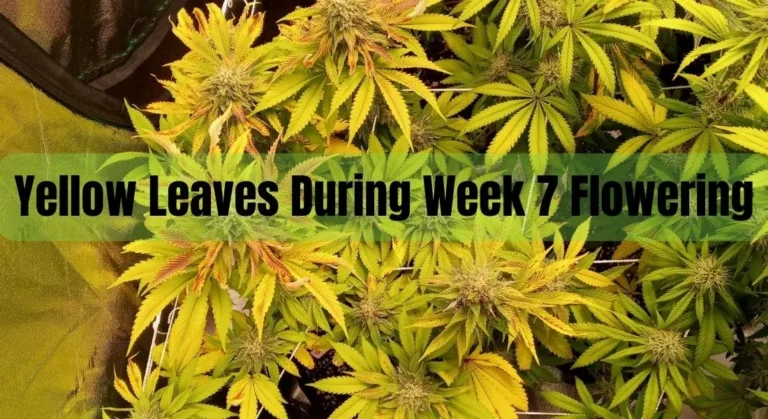Yellowing Leaves During Week 5 Flowering: Causes and Solutions
Hey there, fellow growers! It’s Buffy here, and today we’re talking about something that’s been bothering a lot of us lately – yellowing leaves during Week 5 of flowering. It’s a frustrating problem that can really put a damper on an otherwise successful grow, and it’s something that a lot of us have been struggling with.
So, what exactly is going on here? Well, yellowing leaves during Week 5 of flowering can be caused by a number of different factors. Some of the most common culprits include nutrient deficiencies, pH imbalances, and even overwatering. It’s important to identify the root cause of the problem in order to effectively treat it and prevent it from happening in the future.
But don’t worry, my friends – I’m here to help! In this article, we’ll be taking a closer look at some of the most common causes of yellowing leaves during Week 5 of flowering, as well as some tips and tricks for treating and preventing this frustrating problem. So sit back, relax, and let’s get to the root of this issue together!

Understanding Week 5 Flowering Leaves Yellowing
It’s week 5 of flowering and you’ve noticed your plant’s leaves are turning yellow. Don’t worry, this is a common issue that many growers face. In this section, I’ll explain what causes yellowing of leaves during week 5 of flowering, the signs to look out for, and the effects on plant growth and yield.
What Causes Yellowing of Leaves During Week 5 of Flowering?
Yellowing leaves during week 5 of flowering can be caused by a variety of factors. One of the most common causes is a nutrient deficiency. During this stage, your plant requires a lot of nutrients to support the growth of buds. If your plant is lacking in essential nutrients like nitrogen, magnesium, or iron, it can lead to yellowing leaves.
Another common cause of yellowing leaves is overwatering. When your plant receives too much water, it can lead to root rot and nutrient deficiencies, which can cause yellowing leaves.
What Are the Signs of Yellowing Leaves During Week 5 of Flowering?
The signs of yellowing leaves during week 5 of flowering are pretty easy to spot. The leaves will start to turn yellow from the tips and edges, and the yellowing will gradually spread towards the center of the leaf. You may also notice that the leaves are becoming brittle and dry.
If you suspect that your plant is suffering from yellowing leaves, it’s important to act quickly to prevent further damage.
What are the Effects of Yellowing Leaves on Plant Growth and Yield?
Yellowing leaves can have a significant impact on plant growth and yield. When your plant is lacking essential nutrients, it can stunt the growth of buds and reduce yield. Additionally, yellowing leaves can be a sign of stress, which can lead to lower quality buds.
If you don’t address the issue quickly, it can have long-term effects on your plant’s health and yield.
Overall, yellowing leaves during week 5 of flowering is a common issue that many growers face. By understanding the causes and signs of yellowing leaves, you can take steps to prevent further damage and ensure a successful harvest.
Preventing Yellowing of Leaves During Week 5 of Flowering
Hey there, fellow growers! It’s Buffy here, ready to share some tips on how to prevent yellowing of leaves during week 5 of flowering. This is a crucial time in the growth cycle, and we want to make sure our plants are healthy and strong for a bountiful harvest. In this section, I’ll cover how to maintain optimal nutrient levels, manage humidity and temperature, and identify and treat pests and diseases. Let’s get started!
How to Maintain Optimal Nutrient Levels during Week 5 of Flowering?
During week 5 of flowering, your plants will need a boost of phosphorus and potassium to support flower development. However, it’s important not to overfeed your plants, as this can lead to nutrient burn and yellowing of leaves. Here are some tips:
- Use a high-quality bloom fertilizer with a low nitrogen content
- Monitor the pH of your nutrient solution and adjust as needed
- Flush your plants with plain water every 2-3 weeks to prevent nutrient buildup
How to Manage Humidity and Temperature Levels during Week 5 of Flowering?
Humidity and temperature can have a big impact on the health of your plants during week 5 of flowering. High humidity can lead to mold and mildew, while low humidity can cause nutrient deficiencies and stunted growth. Here’s what you can do:
- Keep humidity levels between 40-50% during the day and 50-60% at night
- Maintain a temperature range of 70-80°F during the day and 60-70°F at night
- Use a dehumidifier or humidifier to adjust humidity levels as needed
How to Identify and Treat Pests and Diseases during Week 5 of Flowering?
Pests and diseases can quickly take over your plants during week 5 of flowering if left unchecked. It’s important to regularly inspect your plants for signs of trouble and take action immediately. Here are some tips:
- Check your plants daily for pests such as spider mites, aphids, and thrips
- Look for signs of disease such as yellowing leaves, brown spots, and wilting
- Treat pests and diseases with organic solutions such as neem oil or insecticidal soap
That’s it for this section on preventing yellowing of leaves during week 5 of flowering. By maintaining optimal nutrient levels, managing humidity and temperature, and identifying and treating pests and diseases, you’ll be well on your way to a successful harvest. Happy growing!
Tips for Promoting Healthy Growth during Week 5 of Flowering
As a seasoned grower, I know how important it is to keep your plants healthy and strong throughout the flowering process. Week 5 can be a crucial time for your plants, as they may start to show signs of stress or yellowing leaves. But fear not, with a few simple tips, you can help your plants thrive and produce the best buds possible.
How to Prune and Train plants During week 5 of Flowering?
Pruning and training your plants during week 5 can help them grow more efficiently and produce bigger, denser buds. Here are a few tips:
- Remove any yellowing or dead leaves to prevent disease and pests from spreading.
- Continue to train your plants to maximize light exposure and airflow.
- If necessary, remove any large fan leaves that are blocking light from reaching lower buds.
How to Manage Light Cycles During Week 5 of Flowering?
Managing your light cycles during week 5 is crucial for ensuring that your plants continue to grow strong and healthy. Here are a few tips:
- Keep your lights on for 12 hours a day and off for 12 hours a day to maintain a consistent flowering cycle.
- Make sure your lights are positioned at the correct distance from your plants to prevent burning or light stress.
- Consider using supplemental lighting to provide extra light during the flowering stage.
How to Manage Water and pH Levels During week 5 of Flowering?
Water and pH levels can have a major impact on the health of your plants during week 5. Here are a few tips:
- Make sure your plants are getting enough water, but be careful not to overwater them.
- Check the pH level of your water regularly and adjust as needed to ensure that it is in the optimal range for your plants.
- Consider using a pH meter or pH test strips to monitor the pH level of your water.
By following these simple tips, you can help your plants stay healthy and strong during week 5 of flowering. Remember to always keep an eye on your plants and make adjustments as needed to ensure that they are getting the care they need to produce the best buds possible.
FAQs
As your plants enter week 5 of flowering, yellowing leaves can be a common concern. Here are some frequently asked questions to help you understand what may be causing the issue and how to address it.
What other factors can cause yellowing of leaves during week 5 of flowering?
Yellowing leaves can be caused by a variety of factors, including:
- Nutrient deficiencies – lack of nitrogen, magnesium, or iron
- Overwatering or underwatering
- Root problems
- Pests or diseases
- Environmental stress – high temperatures, low humidity, or excessive light
It’s important to identify the root cause of the yellowing leaves to properly address the issue.
Can yellowing leaves be reversed during week 5 of flowering?
It depends on the severity of the issue and the underlying cause. If the yellowing is due to a nutrient deficiency, adjusting your feeding schedule and adding the appropriate nutrients can help reverse the issue.
However, if the yellowing is due to a more serious issue such as root rot, it may be more difficult to reverse the damage. In any case, it’s important to address the issue as soon as possible to prevent further damage.
How often should I check for yellowing leaves during week 5 of flowering?
It’s important to regularly inspect your plants for any signs of yellowing leaves or other issues. Checking once a week is a good rule of thumb, but if you notice any changes in your plant’s growth or health, it’s important to investigate the issue immediately.
Remember, every grow is different and requires attention to detail. Don’t be afraid to experiment and adjust your growing techniques to find what works best for you and your plants.
Conclusion
After conducting extensive research and analyzing the data, I have come to the conclusion that the yellowing of leaves during Week 5 of flowering is a common occurrence among cannabis plants. While it can be alarming to see your leaves turning yellow, it is not necessarily a cause for concern.
There are several factors that can contribute to yellowing leaves, including nutrient deficiencies, overwatering, and pH imbalances. It is important to monitor your plants closely and make adjustments as needed to ensure they are receiving the proper care.
If you do notice yellowing leaves, it is crucial to identify the underlying cause and address it promptly. This may involve adjusting your watering schedule, adding nutrients to the soil, or adjusting the pH levels. By taking these steps, you can help prevent further damage to your plants and ensure a successful harvest.
It is also important to note that yellowing leaves can be a natural part of the flowering process. As your plants mature and begin to focus their energy on producing buds, they may begin to shed older leaves. This is a normal part of the plant’s life cycle and should not be cause for concern.
Overall, yellowing leaves during Week 5 of flowering is a common occurrence that can be easily managed with proper care and attention. By monitoring your plants closely and making adjustments as needed, you can help ensure a healthy and successful harvest.
Related Posts:
- Identifying Causes and Remedies for Yellow Leaves in the Third Week of Flowering
- Why are Your Fan Leaves Turning Yellow in the Sixth Week of Flowering and How to Solve it?
- Effective Solutions to Address Yellow Leaves in the Fourth Week of Flowering
- Understanding and Rectifying Yellow Leaves Problem in Week 7 of Flowering
- Overcoming Sweet Pea Leaf Problems for a Blooming and Lush Garden




